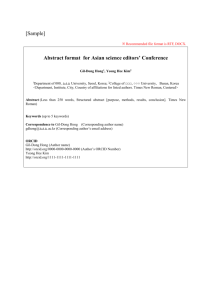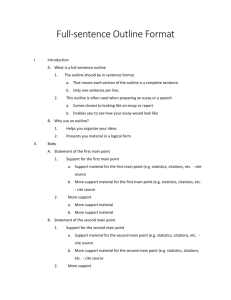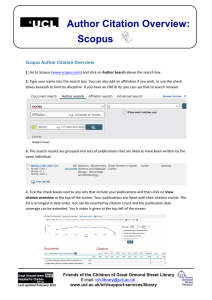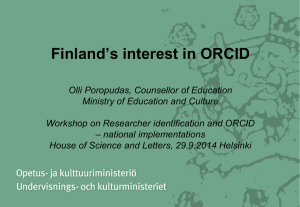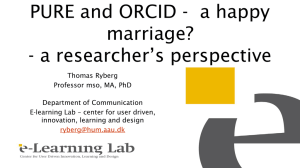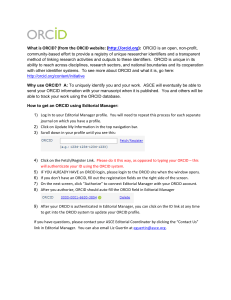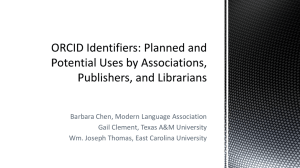Tips for improving citations 2 Bibliometrics in Libraries Meeting Clari Gosling, 12
advertisement
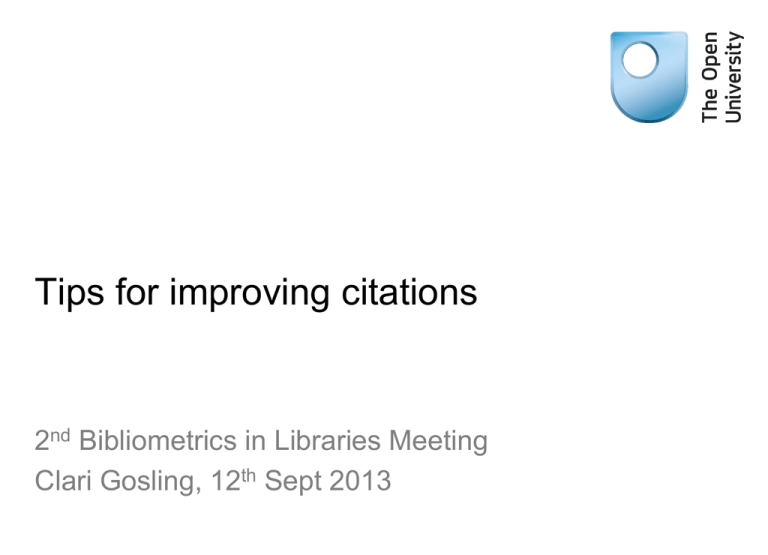
Tips for improving citations 2nd Bibliometrics in Libraries Meeting Clari Gosling, 12th Sept 2013 Questions to start with • What is a citation? • Why do authors cite? • • • • • • • • • • • • • Why are things cited? Justification of a statement/strengthen an argument Avoid plagiarism Show idea development/build on previous work Provide further information Provide counter argument – controversy Provide historical overview of subject Establish trust/credibility Literature review is the accepted way of working They’re what everyone else cites/key papers Cite “out of area” to demonstrate inter-disciplinarity To get into “citation ring”/encourage citations of you The author cited you previously Requested by reviewer/editor for publication In Summary • Authors cite a work because: – It is relevant (in some way) to what they’re writing – They know it exists Information overload • Updated daily, Scopus covers 50 million abstracts of over 20,500 peer-reviewed titles from more than 5,000 publishers • The average time a researcher spends browsing and reading literature in 9.3 hours per week Is this relevant? Findability • Your article needs to show up in search results – Title – Abstract – Keywords • Then it has to hook them in – Introduction – Conclusions – Figures & graphs Search Engine Optimisation • • • • • Headings Links Image & table captions Author information Increasingly takes account of social media mentions too Where to publish • Think about journal rankings • Inclusion in Scopus and Web of Science • Terms and conditions of publishing - do you need to publish Open Access as a requirement of your funder? – Green and gold OA – Author pays model • Cost effectiveness of OA http://www.eigenfactor.org/openaccess/ – Reputation – some OA journals are considered predatory http://scholarlyoa.com/publishers/ Self-citations • Often excluded from citation statistics • But show how your work is developing • Has been studies that show that the more you cite yourself, the more others cite you • “Controlling for numerous sources of variation in cumulative citations from others, our models suggest that each additional self-citation increases the number of citations from others by about one after one year, and by about three after five years. ” • Fowler, J. & Aksnes, D. Does self-citation pay? Scientometrics, September 2007, Volume 72, Issue 3, pp 427-437 International collaborations Author profiles • Why? – Claim your research – Add extra information (website, photo, keywords) – Allow readers to browse your work easily • Where? – ORCID – Scopus – ResearcherID – Google Scholar ORCID • Registry of researchers linking to their outputs • Publisher Independent • Embedding your ORCID in published papers allows readers to find you even if you’ve moved institution • Links to Scopus & ResearcherID so don’t have to enter all your details multiple times http://orcid.org/ Academic social networking sites • Allow you to network with your peers and share your research • Some have the ability to ask and answer research related questions, create groups or share references • Often rank highly in Google and other search engines • Can make your publications available to download (where allowed within t&c of publication) • Talk to colleagues and find out what they’re using • Examples: – Academia.edu; ResearchGate; Mendeley Social Media • “If you tell people about your research, they look at it. Your research will get looked at more than papers which are not promoted via social media” • Michelle Terras at UCL blogged and tweeted about already published research and saw an increase in downloads from their institutional repository • http://blogs.lse.ac.uk/impactofsocialsciences/2012/04/19 /blog-tweeting-papers-worth-it/ Useful intro to using social media in academia • Bik HM, Goldstein MC (2013) An Introduction to Social Media for Scientists. PLoS Biol 11(4): e1001535. doi:10.1371/journal.pbio.1001535 • http://www.plosbiology.org/article/info%3Adoi%2F10.137 1%2Fjournal.pbio.1001535 Things to do • Step 1 publish your research & think about people finding it • Step 2 claim your research & create a profile – ORCID – ResearcherID – Scopus Author Profile – Google Scholar • Step 2b – Profile on an “academic social networking site” eg ResearchGate, Academia.edu, Mendeley • Step 3 engage & publicise – Create your own website – Blog – Twitter – Google+ – Facebook groups – Wikipedia links – Slideshare – Youtube – LinkedIn – Publisher community sites The Open University Library Walton Hall Milton Keynes MK7 6AA www.open.ac.uk/library clari.gosling@open.ac.uk
